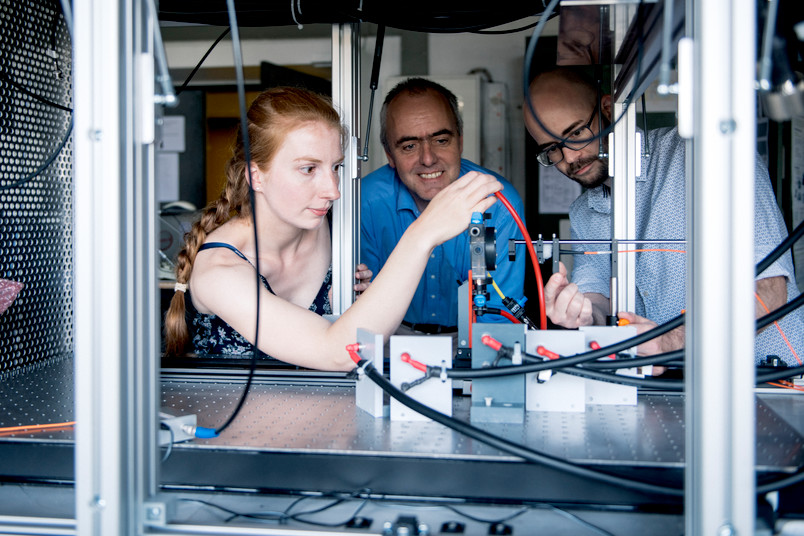Plasma research: Lightning bolt underwater
Researchers from Ruhr-Universität Bochum explored and described for the first time underwater plasmas in detail, which exist only for a few nanoseconds

Katharina Grosse, Achim von Keudell and Julian Held (from the left) in the laboratoy. © RUB, Kramer
A plasma tears through the water within a few nanoseconds. It may possibly regenerate catalytic surfaces at the push of a button.
Electrochemical cells help recycle CO2. However, the catalytic surfaces get worn down in the process. Researchers at the Collaborative Research Centre 1316 “Transient atmospheric plasmas: from plasmas to liquids to solids” at Ruhr-Universität Bochum (RUB) are exploring how they might be regenerated at the push of a button using extreme plasmas in water. In a first, they deployed optical spectroscopy and modelling to analyse such underwater plasmas in detail, which exist only for a few nanoseconds, and to theoretically describe the conditions during plasma ignition. They published their report in the journal Plasma Sources Science and Technology on 4 June 2019.
Video: Experimentalphysik II
Lightning bolt underwater
A plasma tears through the water within a few nanoseconds. Following plasma ignition, there is a high negative pressure difference at the tip of the electrode, which results in ruptures forming in the liquid. Plasma then spreads across those rupture.
Plasmas are ionised gases: they are formed when a gas is energised that then contains free electrons. In nature, plasmas occur inside stars or take the shape of polar lights on Earth. In engineering, plasmas are utilised for example to generate light in fluorescent lamps, or to manufacture new materials in the field of microelectronics. “Typically, plasmas are generated in the gas phase, for example in the air or in noble gases,” explains Katharina Grosse from the Institute for Experimental Physics II at RUB.
Ruptures in the water
In the current study, the researchers have generated plasmas directly in a liquid. To this end, they applied a high voltage to a submerged hairline electrode for the range of several billionth seconds. Following plasma ignition, there is a high negative pressure difference at the tip of the electrode, which results in ruptures forming in the liquid. Plasma then spreads across those ruptures. “Plasma can be compared with a lightning bolt – only in this case it happens underwater,” says Katharina Grosse.
Hotter than the sun
Using fast optical spectroscopy in combination with a fluid dynamics model, the research team identified the variations of power, pressure, and temperature in these plasmas. “In the process, we observed that the consumption inside these plasmas briefly amounts to up to 100 kilowatt. This corresponds with the connected load of several single-family homes,” points out Professor Achim von Keudell from the Institute for Experimental Physics II. In addition, pressures exceeding several thousand bars are generated – corresponding with or even exceeding the pressure at the deepest part of the Pacific Ocean. Finally, there are short bursts of temperatures of several thousand degrees, which roughly equal and even surpass the surface temperature of the sun.
Water is broken down into its components
Such extreme conditions last only for a very short time. “Studies to date had primarily focused on underwater plasmas in the microsecond range,” explains Katharina Grosse. “In that space of time, water molecules have the chance to compensate for the pressure of the plasma.” The extreme plasmas that have been the subject of the current study feature much faster processes. The water can’t compensate for the pressure and the molecules are broken down into their components. “The oxygen that is thus released plays a vital role for catalytic surfaces in electrochemical cells,” explains Katharina Grosse.? “By re-oxidating such surfaces, it helps them regenerate and take up their full catalytic activity again. Moreover, reagents dissolved in water can also be activated, thus facilitating catalysis processes.”
Original publication
Katharina Grosse, Julian Held, Maike Kai, Achim von Keudell: Nanosecond plasmas in water: ignition, cavitation and plasma parameters, in: Plasma Sources Science and Technology 2019, DOI: 10.1088/1361-6595/ab26fc
Funding
This project is supported by the German Science Foundation within the framework of the Coordinated Research Centre 1316.
Source: Ruhr-Universität Bochum, press release, 2019-06-26.
